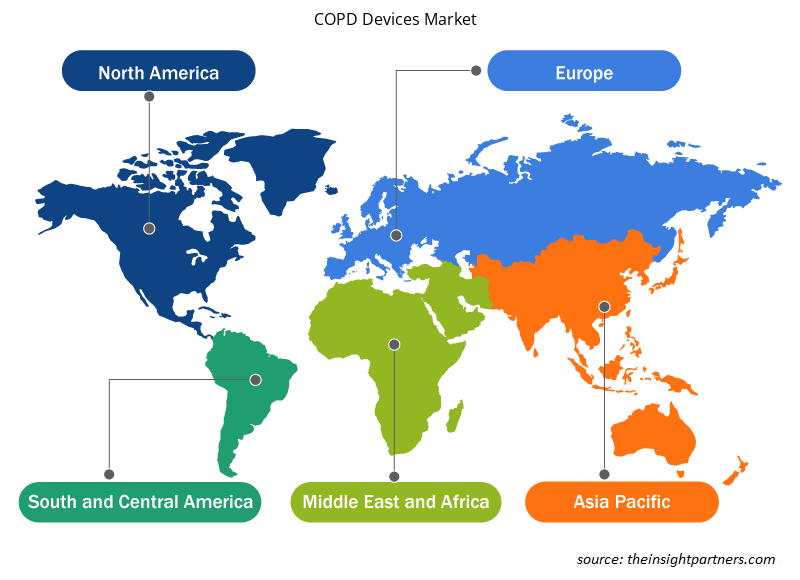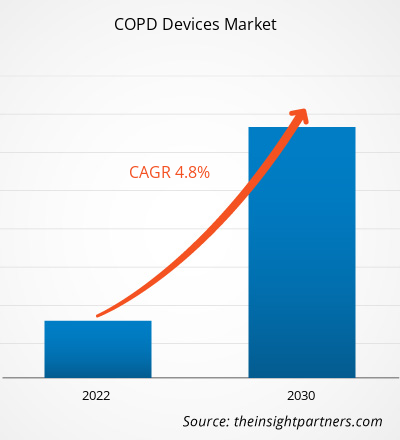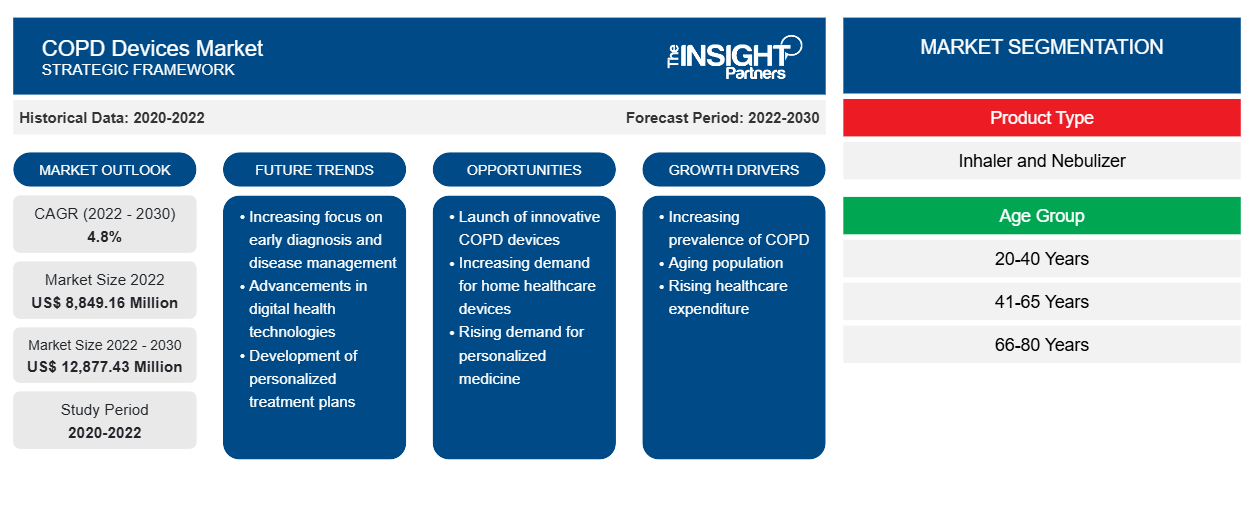[Forschungsbericht] Der Markt für COPD-Geräte soll von 8.849,16 Millionen US-Dollar im Jahr 2022 auf 12.877,43 Millionen US-Dollar im Jahr 2030 wachsen; von 2022 bis 2030 wird eine durchschnittliche jährliche Wachstumsrate (CAGR) von 4,8 % erwartet.
Markteinblicke und Analystenansichten:
COPD ist eine chronische Erkrankung, die eine Lungenentzündung verursacht, das Lungengewebe schädigt und zur Verengung der Atemwege führt, was das Atmen erschwert. Der Markt für COPD-Geräte wächst mit den zunehmenden F&E-Aktivitäten zur Entwicklung intelligenter Inhalatoren zur Behandlung von COPD, der steigenden Zahl von COPD-Fällen und der zunehmenden staatlichen Unterstützung für die Behandlung von COPD. Darüber hinaus treibt die Verfügbarkeit fortschrittlicher Produkte der Marktteilnehmer das Wachstum des Marktes weiter voran. So brachte Glenmark Pharma im Juni 2021 den Tiotropiumbromid-Trockenpulverinhalator auf den Markt, der zur Behandlung von COPD in Großbritannien eingesetzt wird.
Wachstumstreiber und Herausforderungen:
COPD ist eine chronische Lungenerkrankung, die eine Lungenentzündung verursacht, die zu einer Behinderung des Luftstroms aus der Lunge führt. Zu den Symptomen von COPD gehören Atembeschwerden, Schleimbildung (Auswurf), Husten und Keuchen. Die Erkrankung wird in der Regel durch langfristige Einwirkung von reizenden Gasen oder Partikeln, am häufigsten durch Zigarettenrauch , verursacht . Menschen mit COPD haben ein erhöhtes Risiko, an Lungenkrebs, Herzerkrankungen und einer Reihe anderer Leiden zu erkranken. Laut der American Lung Association ist COPD die häufigste Todesursache in den USA, und im Jahr 2022 wurden diese Krankheiten bei mehr als 12 Millionen Amerikanern diagnostiziert. Der gleichen Quelle zufolge wurden in den Jahren 2019–2020 weltweit etwa 8,5 Millionen Erwachsene mit COPD diagnostiziert. Laut der Weltgesundheitsorganisation (WHO) war COPD im Jahr 2021 die dritthäufigste Todesursache weltweit. Die hohe Sterblichkeitsrate bei COPD ist auf akute Exazerbationen zurückzuführen, die zum Versagen der Atemmuskulatur der Patienten führen und in der Folge die Fähigkeit des Patienten, selbstständig zu atmen; Infolgedessen sterben die Patienten an einer systemischen Infektion und Asphyxie. Darüber hinaus wird laut dem Bericht „Burden of Obstructive Lung Disease“ (BOLD) im Jahr 2020 erwartet, dass die Sterblichkeit aufgrund von COPD in den nächsten 40 Jahren weltweit ansteigen wird und bis 2060 voraussichtlich etwa 5,4 Millionen Todesfälle pro Jahr erreichen wird. Die weltweit zunehmende Verbreitung von COPD treibt das Wachstum des Marktes für COPD-Geräte voran.
Passen Sie diesen Bericht Ihren Anforderungen an
Sie erhalten kostenlos individuelle Anpassungen an jedem Bericht, einschließlich Teilen dieses Berichts oder einer Analyse auf Länderebene, eines Excel-Datenpakets sowie tolle Angebote und Rabatte für Start-ups und Universitäten.
- Holen Sie sich die wichtigsten Markttrends aus diesem Bericht.Dieses KOSTENLOSE Beispiel umfasst eine Datenanalyse von Markttrends bis hin zu Schätzungen und Prognosen.
Berichtssegmentierung und -umfang:
Der Markt für COPD-Geräte ist nach Produkttyp, Altersgruppe, Vertriebskanal und Geografie segmentiert. Der Markt für COPD-Geräte ist nach Typ in Inhalator und Vernebler segmentiert. Der Markt für COPD-Geräte ist nach Altersgruppe in 20–40 Jahre, 41–65 Jahre, 66–80 Jahre und 85+ Jahre segmentiert. Der Markt für COPD-Geräte ist nach Vertriebskanal in Krankenhausapotheken, Einzelhandelsapotheken und Online-Apotheken segmentiert. Basierend auf der Geografie ist der Markt für COPD-Geräte in Nordamerika (USA, Kanada und Mexiko), Europa (Großbritannien, Deutschland, Frankreich, Italien, Spanien und Rest von Europa), Asien-Pazifik (China, Australien, Japan, Indien, Südkorea und Rest von Asien-Pazifik), Naher Osten und Afrika (VAE, Saudi-Arabien, Südafrika und Rest von Nahem Osten und Afrika) und Süd- und Mittelamerika (Brasilien, Argentinien und Rest von Süd- und Mittelamerika) kategorisiert.
Segmentanalyse:
Der Markt für COPD-Geräte ist nach Produkttyp in Inhalatoren und Vernebler unterteilt. Im Jahr 2022 hatte das Inhalatorsegment einen größeren Marktanteil und wird im Prognosezeitraum voraussichtlich eine höhere CAGR verzeichnen. Dosieraerosole (MDI) und Trockenpulverinhalatoren (DPI) sind zwei Haupttypen von Inhalatoren zur Behandlung von COPD. Im Gegensatz zu anderen Inhalatoren, die einen Sprühstoß des Medikaments abgeben, enthalten diese Inhalatoren das Medikament als trockenes Pulver. Der Patient muss schnell und tief einatmen, um das Medikament in die Lunge zu bekommen. Trockenpulverinhalatoren sind klinisch geeignete und kostengünstige Alternativen. Dosieraerosole (MDI) sind handgeführte Druckinhalationssysteme, die kleine, präzise Medikamentendosen direkt in die Atemwege eines Patienten abgeben. MDI-Geräte umfassen ein Ventil und einen Aktuator, die eine gleichmäßige Abgabe einer präzisen Medikamentendosis an den Patienten in Partikeln mit einer exakten Größenverteilung ermöglichen, die über ein Treibmittel abgegeben werden. Diese Inhalatoren erfordern Gastreibmittel mit Dampfdruck, die bei Temperaturen zwischen 40 und 70 psi im Behälter verflüssigt werden können. Die in diesen MDIs zur Medikamenteninhalation verwendeten Brennstoffe müssen von der Food and Drug Administration zertifiziert sein. Sie müssen der aktuellen Good Manufacturing Practice (cGMP)-Inhalationsqualität mit hohen Reinheitsgraden entsprechen.
Regionale Analyse:
Geografisch wird der Markt für COPD-Geräte in Nordamerika, Europa, Asien-Pazifik, Naher Osten und Afrika sowie Süd- und Mittelamerika unterteilt. Nordamerika trägt am meisten zum weltweiten Wachstum des Marktes für COPD-Geräte bei. Darüber hinaus wird für den Asien-Pazifik-Raum im Prognosezeitraum die höchste durchschnittliche jährliche Wachstumsrate des weltweiten Marktes für COPD-Geräte erwartet. Das zukünftige Wachstum dieses Marktes ist wahrscheinlich auf die zunehmende Verbreitung von Atemwegserkrankungen zurückzuführen. Auch die chronisch obstruktive Lungenerkrankung (COPD) stellt in den USA eine große Gesundheitsbelastung dar. COPD wird durch eine Behinderung des Luftstroms aus der Lunge verursacht, was zu einer chronisch-entzündlichen Lungenerkrankung führen kann. Rauchen ist eine der Hauptursachen für COPD in den USA. Die zunehmende Vorliebe für das Rauchen in den USA treibt das Wachstum des Marktes für COPD-Geräte voran. Laut den Centers for Disease Control and Prevention (CDC) leiden in den USA etwa 14,8 Millionen Erwachsene an COPD.
Darüber hinaus beträgt die Zahl der Menschen im Alter von 65 Jahren und älter in den USA laut der Administration for Community Living 54,1 Millionen, was 16 % der Gesamtbevölkerung entspricht. Bis 2040 wird dieser Anteil voraussichtlich auf 21,6 % steigen. Ältere Menschen sind extrem anfällig für chronische Atemwegserkrankungen. Daher wird erwartet, dass ein Anstieg der älteren Bevölkerung im Prognosezeitraum auch die Nachfrage nach Ateminhalatoren steigern wird. Darüber hinaus werden günstige Erstattungsrichtlinien voraussichtlich mehrere Möglichkeiten für das Wachstum des Marktes für COPD-Geräte in der Region schaffen.
Regionale Einblicke in den Markt für COPD-Geräte
Die regionalen Trends und Faktoren, die den COPD-Gerätemarkt während des Prognosezeitraums beeinflussen, wurden von den Analysten von Insight Partners ausführlich erläutert. In diesem Abschnitt werden auch COPD-Gerätemarktsegmente und -geografie in Nordamerika, Europa, im asiatisch-pazifischen Raum, im Nahen Osten und Afrika sowie in Süd- und Mittelamerika erörtert.

- Erhalten Sie regionale Daten zum COPD-Gerätemarkt
Umfang des Marktberichts zu COPD-Geräten
| Berichtsattribut | Details |
|---|---|
| Marktgröße im Jahr 2022 | 8.849,16 Millionen US-Dollar |
| Marktgröße bis 2030 | 12.877,43 Millionen US-Dollar |
| Globale CAGR (2022 - 2030) | 4,8 % |
| Historische Daten | 2020-2022 |
| Prognosezeitraum | 2022–2030 |
| Abgedeckte Segmente | Nach Produkttyp
|
| Abgedeckte Regionen und Länder | Nordamerika
|
| Marktführer und wichtige Unternehmensprofile |
|
Dichte der Marktteilnehmer für COPD-Geräte: Auswirkungen auf die Geschäftsdynamik verstehen
Der Markt für COPD-Geräte wächst rasant. Die Nachfrage der Endverbraucher steigt aufgrund von Faktoren wie sich entwickelnden Verbraucherpräferenzen, technologischen Fortschritten und einem größeren Bewusstsein für die Vorteile des Produkts. Mit der steigenden Nachfrage erweitern Unternehmen ihr Angebot, entwickeln Innovationen, um die Bedürfnisse der Verbraucher zu erfüllen, und nutzen neue Trends, was das Marktwachstum weiter ankurbelt.
Die Marktteilnehmerdichte bezieht sich auf die Verteilung der Firmen oder Unternehmen, die in einem bestimmten Markt oder einer bestimmten Branche tätig sind. Sie gibt an, wie viele Wettbewerber (Marktteilnehmer) in einem bestimmten Marktraum im Verhältnis zu seiner Größe oder seinem gesamten Marktwert präsent sind.
Die wichtigsten auf dem Markt für COPD-Geräte tätigen Unternehmen sind:
- AstraZeneca PLC
- Beximco Pharmaceuticals Ltd
- Getinge AB
- Boehringer Ingelheim
- GSK Plc
Haftungsausschluss : Die oben aufgeführten Unternehmen sind nicht in einer bestimmten Reihenfolge aufgeführt.

- Überblick über die wichtigsten Akteure auf dem COPD-Gerätemarkt
Branchenentwicklungen und zukünftige Chancen:
Nachfolgend sind verschiedene Pläne der wichtigsten Akteure auf dem Markt für COPD-Geräte aufgeführt:
- Im April 2022 brachte GlaxoSmithKline Pharmaceuticals Limited Trelegy Ellipta (Fluticasonfuroat/Umeclidinium/Vilanterol) in Indien auf den Markt. Es handelt sich um die erste Einzelinhalator-Dreifachtherapie (SITT) für COPD-Patienten in einem einmal täglichen Regime. Das Produkt wurde außerdem vom Drugs Controller General of India (DCGI) für die Einnahme von Trelegy Ellipta als Erhaltungstherapie zur Vorbeugung und Linderung von COPD-bezogenen Symptomen bei Patienten ab 18 Jahren zugelassen.
Wettbewerbslandschaft und Schlüsselunternehmen:
Einige der führenden Akteure auf dem Markt für COPD-Geräte sind AstraZeneca PLC, Beximco Pharmaceuticals Ltd, Getinge AB, Boehringer Ingelheim, GSK Plc, Medtronic PLC, Nephron Pharmaceuticals, Novartis AG, Sunovion Pharmaceuticals Inc und Teva Pharmaceuticals. Diese Unternehmen konzentrieren sich auf geografische Expansionen und die Einführung neuer Produkte, um die weltweit wachsende Verbrauchernachfrage zu befriedigen und ihre Produktpalette in Spezialportfolios zu erweitern. Ihre globale Präsenz ermöglicht es ihnen, einen großen Kundenstamm zu bedienen und so die Marktexpansion zu erleichtern.
- Historische Analyse (2 Jahre), Basisjahr, Prognose (7 Jahre) mit CAGR
- PEST- und SWOT-Analyse
- Marktgröße Wert/Volumen – Global, Regional, Land
- Branchen- und Wettbewerbslandschaft
- Excel-Datensatz
Aktuelle Berichte
Erfahrungsberichte
Grund zum Kauf
- Fundierte Entscheidungsfindung
- Marktdynamik verstehen
- Wettbewerbsanalyse
- Kundeneinblicke
- Marktprognosen
- Risikominimierung
- Strategische Planung
- Investitionsbegründung
- Identifizierung neuer Märkte
- Verbesserung von Marketingstrategien
- Steigerung der Betriebseffizienz
- Anpassung an regulatorische Trends





















 Kostenlose Probe anfordern für - Markt für COPD-Geräte
Kostenlose Probe anfordern für - Markt für COPD-Geräte